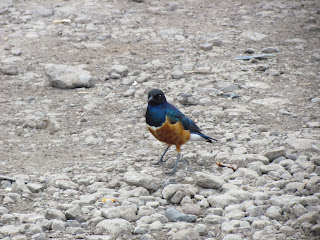The Ngorongoro Crater, a landform created by a collapsed caldera, is amazing! At the top of this conservation area, in the forest, it’s so cool you can wear a fleece. In the crater, with direct sun, its close to 100 degrees. And at the gate, the baboons, unlike at other national parks in the area, are so aggressive they will steal your oranges. Out of your hand. One of the smaller monkeys even jumped up and clung onto the open window of the car, looking around inside for things to steal.
View of the crater
Wildebeest
Warthogs snuggling
Posing for the camera
The blue color on this bird is so pretty in the sunlight
African buffalo
Here we saw lions for the first time as well as critically endangered black rhinos, but only from a distance.
Lioness on the prowlShe's definitely eyeing that zebra
We also had a lecture with a tourism officer at the site for Environmental Policy class. The conservation area is special because it protects wildlife and also allows for human inhabitants. Many local tribes live in the ecosystem, including the Maasai, Datooga and Bushmen, who live off of bushmeat, like antelope.
These tribes are traditionally nomads and pastoralists, so it was cool to learn about the interactions between wildlife in the park and their livestock. There is a disease that affects livestock and wildebeest, so the tribes do their best to separate them such that during the rainy season when the wildebeest inhabit the crater, the pastoralists bring their livestock up to the highlands to avoid disease transmission.
In addition, the Bushmen are one of the few tribes that are almost entirely untouched by Western influence. They even are allowed to hunt at the edge of the protected area, which we have learned can be sustainable depending on the populations of the hunted species. In some cases, hunting can promote tourism while preserving wildlife, such that if some animals are killed, people will recognize their value, decrease demand for their tusks etc. and attempt to preserve them. In certain African countries, the elephant populations are so high that wildlife managers perform culling (purposely killing them).
The following day, for our travelling lecture, we planted trees with kids from the secondary school and made bricks with a sustainable brick company. I planted a Grevillea tree with a freshman at the school, who wrote down my name and labeled the tree. They told us all that we could come back and check on how our tree was growing. The school had an impressive amount of environmental initiatives.
Afterwards we made a stop at a site in the middle of nowhere where they were making bricks by merely using compression rather than fire. By doing this, they save lots of trees that they would otherwise have to deforest. The bricks fit together like puzzle pieces and require no mortar, and last as long as burned bricks. It was really impressive!!
So far the academics are getting pretty intense…I was up until 2 am last night doing a powerpoint presentation for today. However, the rest of the day was a non-program day so we all went to Happy Days and got some American food. We have exams in a few days so wish me luck!














No comments:
Post a Comment